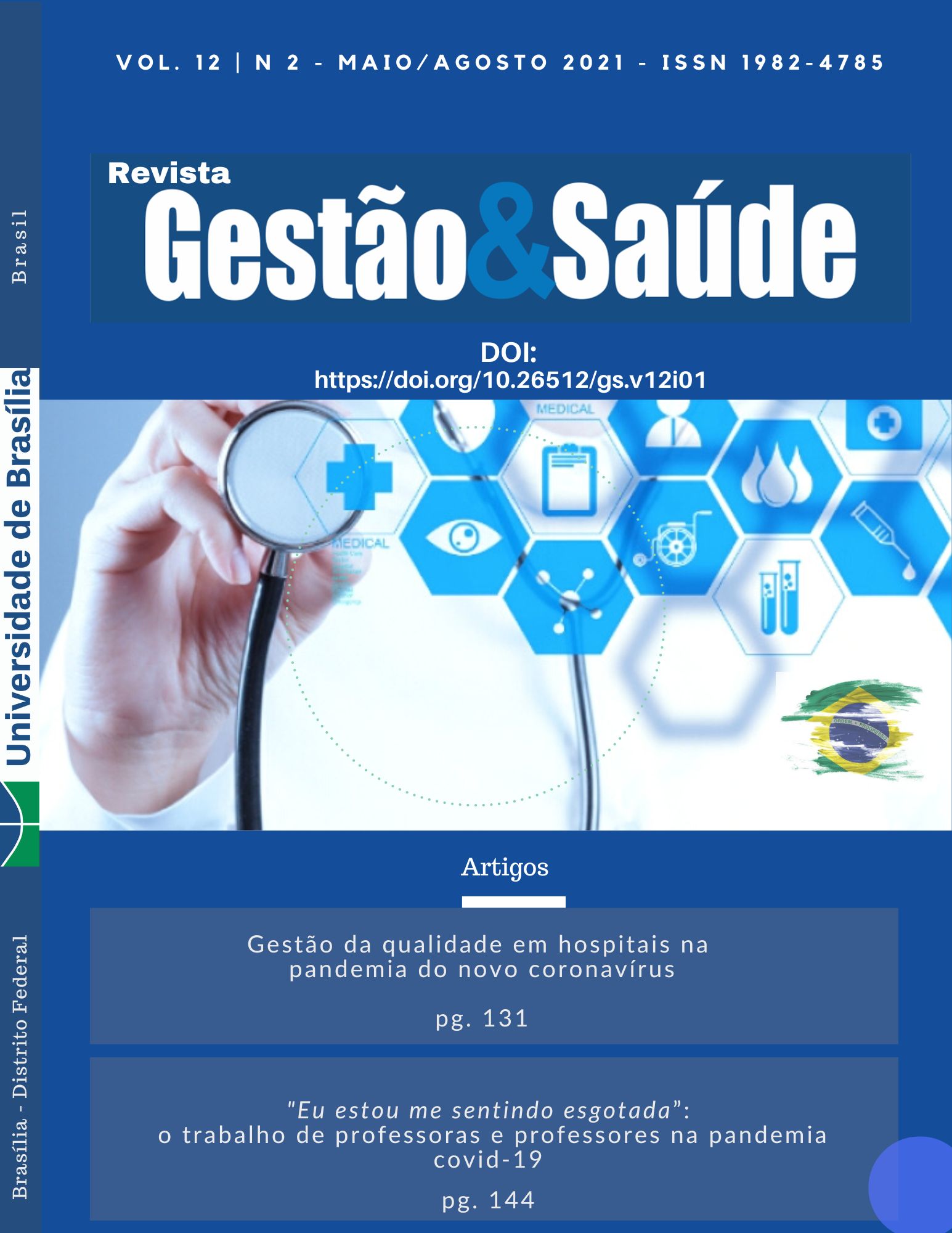“Eu estou me sentindo esgotada”
o trabalho de professoras e professores na pandemia COVID-19
DOI:
https://doi.org/10.26512/gs.v12i02.38766Keywords:
Occupational Health, Professor, COVID 19 Pandemic, Mental Health, Working ConditionsAbstract
This study aims to analyze the organization, conditions and working experiences of teachers in Brazil during the COVID-19 pandemic. This is an exploratory-descriptive study with a mixed methodology design. An online questionnaire with both open and closed questions was used as a data collection instrument. Data were analyzed through simple statistics and thematic analysis. A total of 61 teachers participated in this research, whose average age was 42.7 years. The results suggested that the participants have been working more, have been working more overtime, have been doing more housework, and have been putting an effort to meet the same number of – or even more – deadlines and goals. Symptoms which are associated with depression, such as sadness, discouragement, hopelessness, tiredness and exhaustion, have also been identified. It was concluded that Brazilian teachers have been experiencing an increasing precariousness of both organization and working conditions throughout the pandemic, which demands immediate health, labor protection and social public policies.
Downloads
References
WHO. Naming the coronavirus disease (COVID-19) and the virus that causes it. WHO [Internet]. 2020; Available from: http://who.int/emergencies/diseases/novel-coronavirus-2019/technical-guidance/naming-the-coronavirusdisease-(COVID-2019)-and-the-virus-that-causes-it
WHO. Rollings updates on coronavirus disease [Internet]. Rollings updates on coronavirus disease. 2020. p. 0. Available from: https://www.who.int/emergencies/diseases/novel-coronavirus-2019/events-as-they-happen
JHU. Coronavirus resource center [Internet]. Coronavirus resource center. 2021. Available from: https://coronavirus.jhu.edu/
Gallasch CH, Cunha ML da, Pereira L de S, Silva-Junior JS. Prevenção relacionada à exposição ocupacional do profissional de saúde no cenário de COVID-19. Rev enferm UERJ. 2020;
Zhang J, Feng B, Wu Y, Xu P, Ke R, Dong N. The effect of human mobility and control measures on traffic safety during COVID-19 pandemic. PLoS One. 2021;16(3 March 2021):493–7.
Mizumoto K, Kagaya K, Zarebski A, Chowell G. Estimating the asymptomatic proportion of coronavirus disease 2019 (COVID-19) cases on board the Diamond Princess cruise ship, Yokohama, Japan, 2020. Eurosurveillance [Internet]. 2020;25(10):1–5. Available from: http://dx.doi.org/10.2807/1560-7917.ES.2020.25.10.2000180
Aquino EML, Silveira IH, Pescarini JM, Aquino R, de Souza-Filho JA. Social distancing measures to control the COVID-19 pandemic: Potential impacts and challenges in Brazil. Cienc e Saude Coletiva. 2020;25:2423–46.
Pereira HP, Santos FV, Manenti MA. Boletim de Conjuntura Energética. Rev UFRR [Internet]. 2020;2:41–8. Available from: http://www.udop.com.br/download/estatistica/biomassa/2009a2013_balanco_bagaco_cana_uso_energetico.pdf%5Cnhttp://www.udop.com.br/download/estatistica/biomassa/2014_balanco_bagaco_cana_uso_energetico.pdf
Educação CN de. RESOLUÇÃO CNE/CP No 2, DE 10 DE DEZEMBRO DE 2020 [Internet]. RESOLUÇÃO CNE/CP No 2, DE 10 DE DEZEMBRO DE 2020. 2020. Available from: https://www.in.gov.br/en/web/dou/-/resolucao-cne/cp-n-2-de-10-de-dezembro-de-2020-293526006
Oliveira DA. Condições de trabalho docente e a defesa da escola pública: fragilidades evidenciadas pela pandemia. Rev USP. 2020;(127):27–40.
Instituto Nacional de Estudos e Pesquisas Educacionais Anísio Teixeira. Microdados do Censo Escolar da Educação Básica 2019 [Internet]. Microdados do Censo Escolar da Educação Básica 2019. 2020. Available from: https://www.gov.br/inep/pt-br/acesso-a-informacao/dados-abertos/microdados/censo-escolar
Gonzalez T, De la Rubia MA, Hincz KP, Comas-Lopez M, Subirats L, Fort S, et al. Influence of COVID-19 confinement on students’ performance in higher education. PLoS One [Internet]. 2020;15(10 October):1–23. Available from: http://dx.doi.org/10.1371/journal.pone.0239490
Tostes MV, Albuquerque GSC de, Silva MJ de S e, Petterle RR. Sofrimento mental de professores do ensino público. Saúde em Debate. 2018;42(116):87–99.
Machado FKS, Giongo CR, Mendes JMR. A precarização do trabalho na pandemia de Covid-19: o sofrimento social em questão. In: Saúde do Trabalhador em tempos de desconstrução: caminhos de luta e resistência [Internet]. 2020. Available from: http://renastonline.ensp.fiocruz.br/sites/default/files/arquivos/recursos/almanaque_st.pdf
Tatagiba AB. CRESWELL, John W. Projeto de pesquisa: métodos qualitativo, quantitativo e misto; tradução Magda Lopes. – 3 ed. – Porto Alegre: ARTMED, 296 páginas, 2010. Cad Ling e Soc. 2012;13(1).
Minayo MC de S. O desafio do conhecimento: pesquisa qualitativa em saúde. 2014. 269 p.
Bezerra ACV, da Silva CEM, Soares FRG, da Silva JAM. Factors associated with people’s behavior in social isolation during the covid-19 pandemic. Cienc e Saude Coletiva. 2020;25:2411–21.
Dejours C, Abdoucheli E. Itinerário teórico em psicopatologia do trabalho. Psicodin do Trab Contrib da Esc Dejouriana à análise da relação prazer, sofrimento e Trab. 1994;(January).
Downloads
Published
How to Cite
Issue
Section
License
Copyright (c) 2022 ELECTRONIC JOURNAL MANAGEMENT AND HEALTH

This work is licensed under a Creative Commons Attribution-NoDerivatives 4.0 International License.
I declare that this article is original and has not been submitted for publication in any other national or international journal, either in whole or in part. I further declare that once published in the Electronic Journal Management and Health published by the University of Brasília, it will never be submitted by me or any of the other coauthors to any other means of scientific dissemination.
Through this instrument, in my name and in the name of the other coauthors, may I soon copy the copyright of the article to Electronic Journal Management and Health and declare that I am aware that failure to comply with this commitment will subject the violator to penalties and penalties Law of Protection of Rights Authorities (Nº9609, of 02/19/98).


